All 19 Penguin Species (Inc 1 New Australian Species)
There are few animals worse suited to terrestrial locomotion than the penguin! But what these relatable flightless birds lack in terrestrial prowess, they more than makeup for in aquatic expertise. Underneath the surface, their streamlined bodies and powerful flippers help them hunt with impressive agility and travel long distances with ease. Penguins are subject to a handful of spectacular colour aberrations and range considerably in size and appearance from the fairy or little penguin of New Zealand, through the colourful crested and equally eye-catching banded groups, all the way to Antarctica’s pride and joy, the Emperor.


Left: Pair of King penguins / Shutterstock & Right: The spectacular crest of the Macaroni penguin / Shutterstock
Contents
- Great Penguins | Aptenodytes
- King penguin | Aptenodytes patagonicus
- Emperor penguin | Aptenodytes forsteri
- Brush-tailed penguins | Pygoscelis
- Gentoo penguin | Pygoscelis papua
- Chinstrap penguin | Pygoscelis antarcticus
- Adélie penguin | Pygoscelis adeliae
- Banded Penguins | Spheniscus
- African penguin | Spheniscus demersus
- Galápagos penguin | Spheniscus mendiculus
- Humboldt penguin | Spheniscus humboldti
- Magellanic penguin | Spheniscus magellanicus
- Crested Penguins | Eudyptes
- Macaroni penguin | Eudyptes chrysolophus
- Royal penguin | Eudyptes schlegeli
- Northern rockhopper penguin | Eudyptes chrysocome
- Southern rockhopper penguin | Eudyptes moseleyi
- Snares penguin | Eudyptes robustus
- Fiordland penguin | Eudyptes pachyrhynchus
- Erect-crested penguin | Eudyptes sclateri
- Little Penguins | Eudyptula
- Little penguin | Eudyptula minor
- Australian little penguin | Eudyptula novaehollandiae
- Large Diver Penguins | Megadyptes
- Yellow-eyed penguin | Megadyptes antipodes
Great Penguins | Aptenodytes
King penguin | Aptenodytes patagonicus
As sea birds, penguins spend a great deal of their time in the water, often passing months at sea. All species, however, come ashore to breed and are well-known for their enormous colonies, sometimes numbering millions of birds. The King penguin breeds on several subantarctic islands between 45° and 60° south including South Georgia, where their colony is estimated to number over 200,000 birds. This beautiful island is teaming with wildlife, hosting four species of penguin and several species of seal to name but a few.

King penguins are unique in their breeding cycle, which lasts 14-18 months, in comparison to the yearly cycle of most other species. This is due to the abnormally long time it takes chicks to reach independence, which occurs at 12-14 months of age in comparison to 5 months for emperor chicks and 2-3 months for most other species. Chicks are also quite striking, displaying thick down feathers that are brown in colour in comparison to the black or grey feathers of many other species.

More developed chicks are left in créches, which amount to large groups of young, supervised by a small number of adults while the majority of parents hunt for food. Amazingly, parents are able to locate their young even in massive groups by using vocalisations recognized by the chick. Before entering the water themselves, chicks will moult their down feathers, which are replaced by stiff waterproof ones. Adults also undergo a similar process every year, replacing their worn-out feathers with a newer more waterproof layer.

The most eye-catching version of the king penguin is its melanistic form, which sees ventral feathers jet black instead of white. This species is one of two great penguins and is only surpassed in weight and height by the other species, found to the south.

Emperor penguin | Aptenodytes forsteri
The Emperor penguin is the largest of all 19 species, standing just over 4 ft tall (50 in / 130 cm) and is also the deepest diver, reaching a recorded maximum depth of 565 m / 1854 ft while it searches for fish, mollusks and crustaceans. Although the emperor penguin is larger, they are less colourful than their king cousins who have a more vibrant patch of orange towards the back of the head, which runs down the neckline and fades onto the chest.
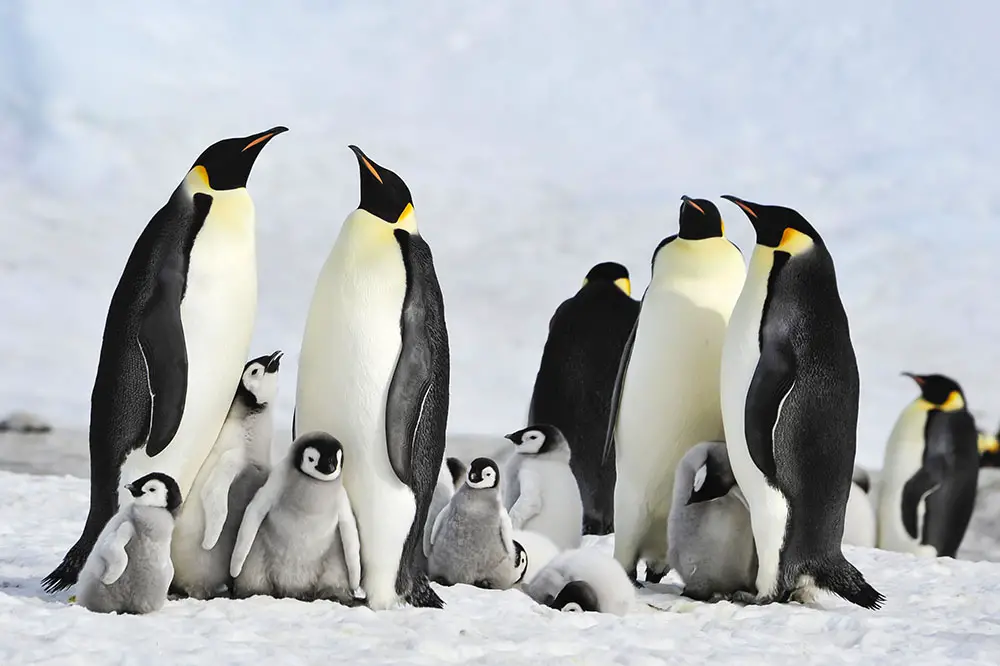
Breeding takes place once yearly commencing in March and April after a long period spent at sea foraging for food. This coincides with the beginning of Antarctica’s harsh winter conditions, which can witness temperatures as low as -50°C (-58°F) and winds as high as 200 kph (124 mph). A single egg is laid by the female in May or June, which is immediately incubated by the male using a patch of skin on his belly and his fat stores to withstand the cold while the female takes on the equally arduous task of trekking up to 160 km (100 miles) over the sea ice back to the ocean to find food.

It is thought that this species breeds during these harsh conditions to give their chicks the best possible chance of surviving, reaching independence at the end of the summer season when their down feathers have moulted and they are ready to fend for themselves. The emperor penguin also displays one of the best examples of “tobogganing”, a type of terrestrial locomotion used to take advantage of the icy conditions. The Emperor is one of only two penguin species to call the frozen continent their true home but one of five that frequent the shores of Antarctica.

Brush-tailed penguins | Pygoscelis
Gentoo penguin | Pygoscelis papua
The first of these birds is the Gentoo penguin, which can be distinguished by a red beak, a white patch that runs from eye to eye across the top of the head and particularly vibrant orange-red feet. Like other species, they occasionally exhibit leucism and other colour aberrations, which can produce an entirely white plumage or more of a faded brown colouration. While some Gentoos breed in Antarctica, others frequent subantarctic islands further north to build their nests. These are constructed either with vegetation such as grass or rocks depending on the environment and available materials. This species lays between one to three eggs on a yearly cycle and after 100 days of nurturing, the young reach independence but won’t reach sexual maturity until 2-3 years of age.

Weighing no more than 18.75 lb (8.5 kg), although Gentoos are much smaller than the great penguins previously discussed, they hold the record for the fastest underwater birds, clocking speeds of up to 36 kph (22.5 mph), which for the sake of comparison is four times the speed of Michael Phelps! Penguins use a type of aquatic locomotion referred to as porpoising, which sees groups of birds breaching the surface in a smooth efficient motion to take in air. Gentoos can often be seen alongside our next species, the second and smallest of the brush-tailed penguins.
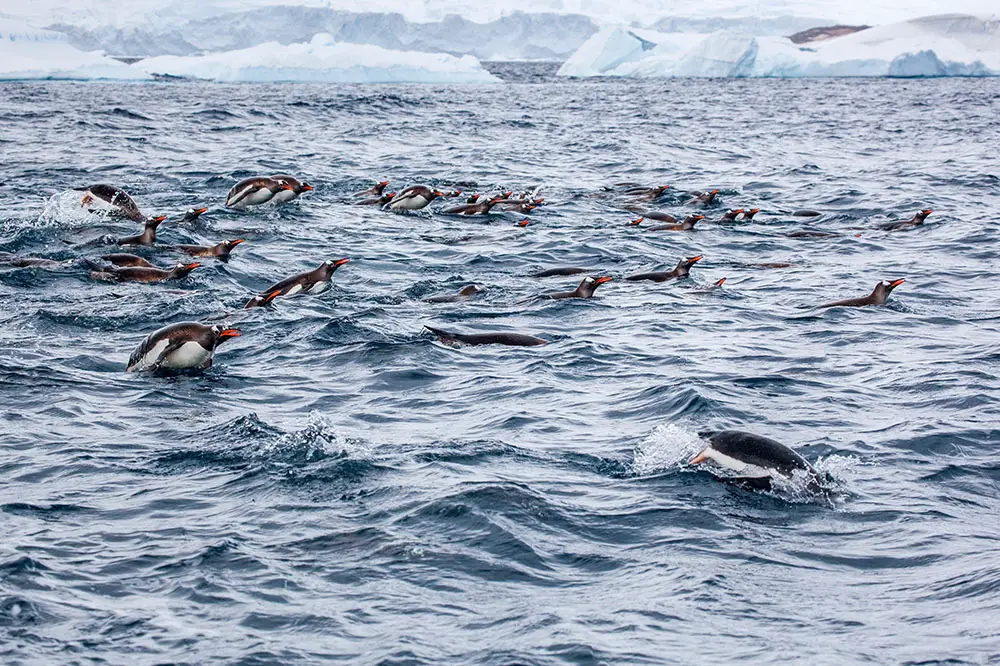
Chinstrap penguin | Pygoscelis antarcticus
As you might expect, this species can be easily identified by a black line of feathers that runs from ear to ear underneath the beak, in addition to a black ring around the eye and a black beak. The chinstrap’s claim to fame is the largest breeding colony of any penguin with over 1 million birds residing on Zavodovski Island, one of the South Sandwich Islands that sits just over 500 km southeast of South Georgia. These birds are known to scramble to the highest slopes which are the first to become free of the sea ice. Like most species, chinstraps lay two eggs, which the parents take turns incubating while the other forages for food, which can be up to 95% krill. This food is then regurgitated for the chick to eat. Once moulting is complete, chicks are ready to fend for themselves in the open ocean. Both chinstraps and Gentoos are closely related to one more species; the final member of the brush-tailed group.
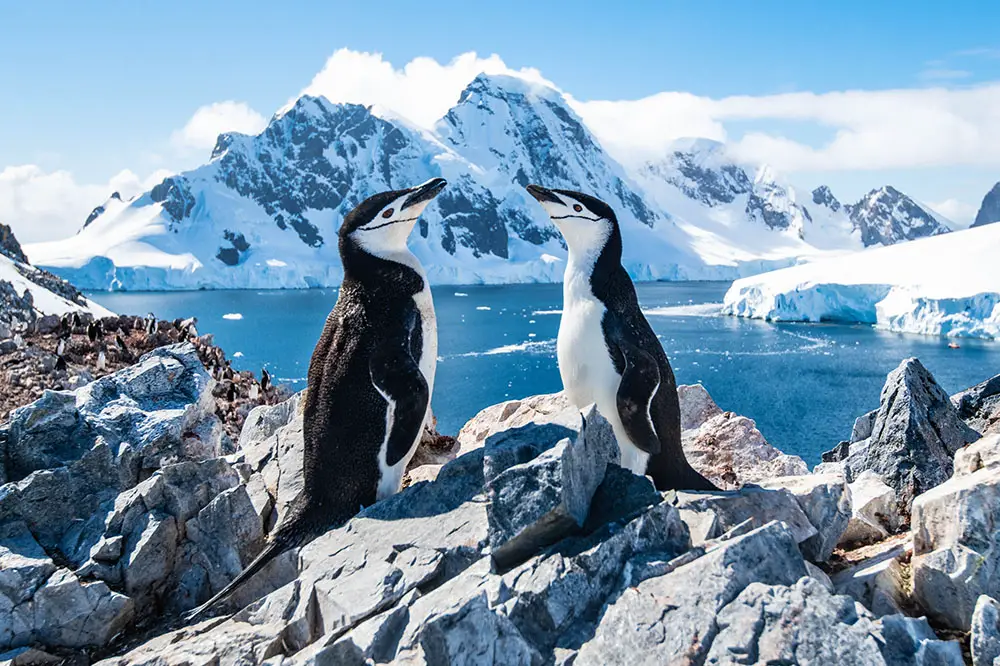
Adélie penguin | Pygoscelis adeliae
The Adélie penguin is characterised by its jet-black hood with a small ring of white feathers around the eyes. These rings are not present in juveniles who exhibit an entirely black-grey plumage that shifts to adult colouration with age. It is another species which can, occasionally, be found in leucistic and brown aberrations. Like all penguins, Adélies use a type of camouflage known as countershading; in the water, the dark feathers on their dorsal side make them hard to spot from above, blending into the depths of the ocean and their white ventral side makes them harder to see from below, blending into the sunlight above.

It is another species which subsists on the abundant supply of krill in the Antarctic waters and, on the other side of the food chain, is preyed upon by several animals including killer whales and leopard seals. The Adélie penguin is the second species, alongside the Emperor, to exist primarily on the Antarctic continent but can also be found on a few subantarctic islands, one of which bridges the gap nicely to the only species to exclusively breed on the African continent.

Banded Penguins | Spheniscus
African penguin | Spheniscus demersus
The African penguin is the first species we’ll discuss from a genus commonly referred to as the banded penguins. Their feather pattern is unique from other groups, displaying bands of white and black feathers along the sides of the body and head, and onto the top of the chest. Also referred to as the Cape penguin or the jackass penguin, for their donkey-like courting vocalisations, this species can be found in the beautiful clear blue waters of southern Africa, from Namibia in the north to South Africa in the south.

Aside from their beautiful surroundings, African penguins are unique from those previously discussed in the construction of their nests, which are built in the form of shallow burrows dug into the sand or can also be made in a similar fashion using areas of vegetation or a simple depression in the sand. In order to keep their feathers clean and waterproof, all penguins engage in a behaviour known as preening, where they use their beaks to apply an oil secreted from a gland at the base of the tail to the rest of their body. The African penguin is unfortunately the first species we’ve covered that is listed as Endangered, a conservation status shared with another banded penguin found on the equator.

Galápagos penguin | Spheniscus mendiculus
The bands on the Galápagos penguin are the least prominent of all banded penguins and they are also the smallest of this group topping out at 5.75 lb (2.6 kg). These smaller penguins are no less impressive in the water and use their flippers to propel their aerodynamic bodies through the water in pursuit of prey at speeds of up to 35 kph (21.75 mph). The Galapagos islands is one of the most renowned locations for marine life and the penguins here hunt anchovies, sardines and mullet, all of which are referred to as cold-water schooling fish.
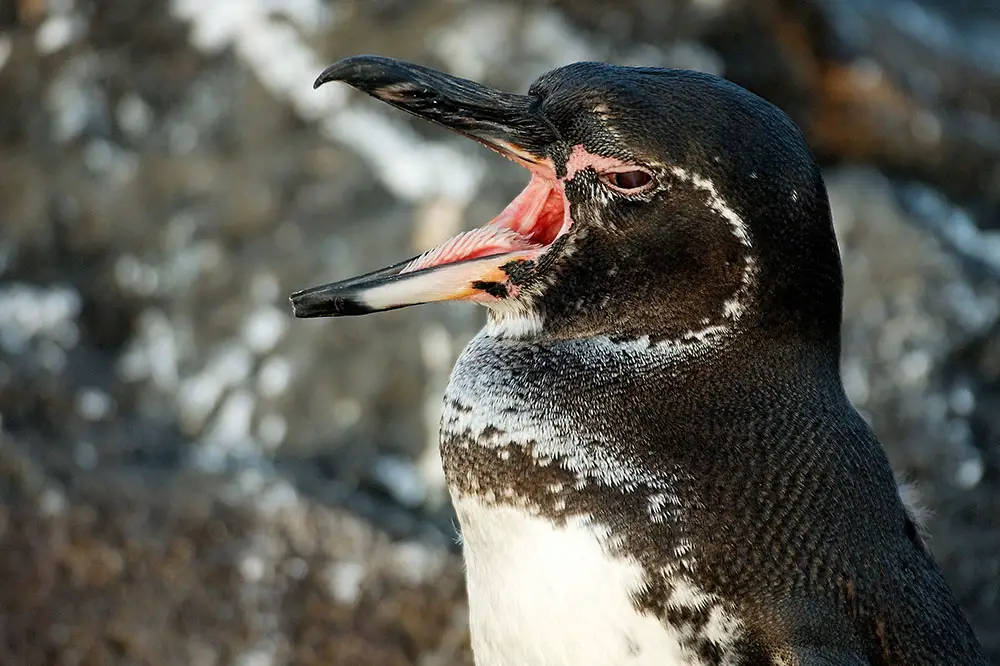
They are preyed upon by various species of seals and sharks in the water and are vulnerable to birds of prey, snakes and mammals such as feral cats and dogs on land. The Galápagos is the most northerly species of penguin and by a small margin the only species to exist in the Northern Hemisphere, with the northernmost tip of their range straddling the equator; it is able to survive in these northerly waters thanks to a current system known as the Humboldt current, which transports cool water from Antarctica up the western coast of South America and after which our next species is named.
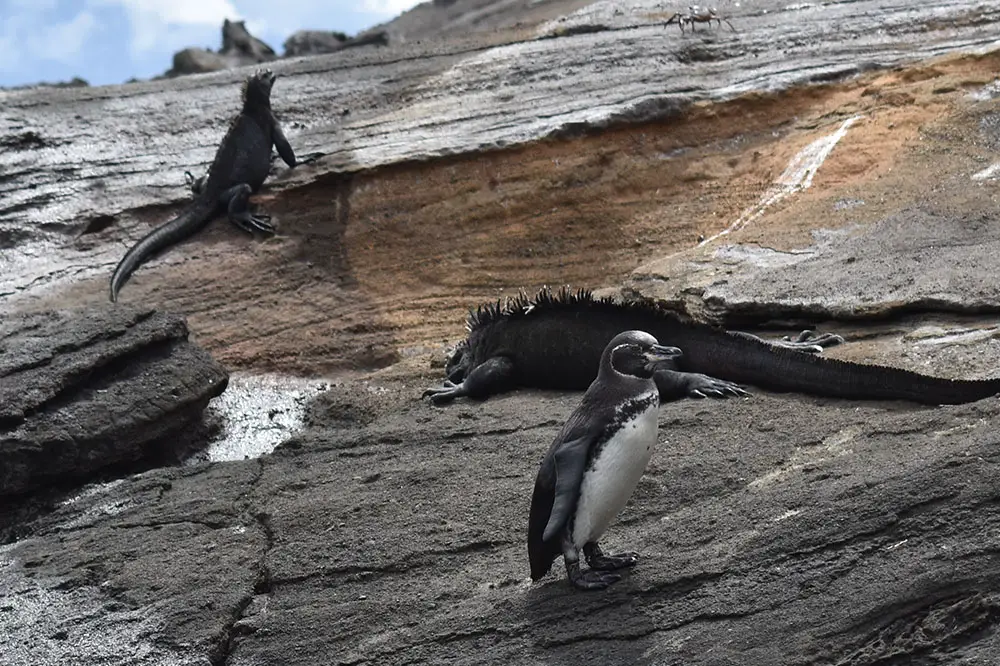
Humboldt penguin | Spheniscus humboldti
The Humboldt penguin is visually more similar to the African penguin than it is to the Galapagos but has a larger area of pink flesh which extends to the base of the beak and a thinner white line of feathers on the side of the face. At up to 11 lb (5 kg) it is larger than both its African and equatorial equivalents. This species has an unusual breeding season, which takes place year-round but peaks between April to July and August to December. This often means many Humboldt penguins can successfully breed twice per year.

This species is also unique from most other penguins in that they do not form crèches; rather parents leave their chicks by the nest while they forage for food. To assist with this foraging, all penguins have rows of pronounced teeth-like papillae which face towards the back of the mouth and help the penguin grip fish and direct it into their bellies instead of slipping out in the opposite direction. The Humboldt penguin is present along the west coast of South America, from Peru in the north to Chile in the south where its range overlaps with the last banded species to explore.

Magellanic penguin | Spheniscus magellanicus
The Magellanic penguin is a little larger than any of the banded penguins previously discussed and has a feather pattern most similar to the African penguin with a large white band of feathers on the side of the head and a smaller area of pink flesh around and on top of the eyes. It can be distinguished from the African penguin by the presence of an additional black band around the neckline. This species is named after Portuguese explorer Ferdinand Magellan, after which the Strait of Magellan is also named and located in the same area.

This is one species for which I was able to find photos of a true albino penguin. This colouration differs from that of a leucistic penguin by a lack of pigmentation in the beak, skin and eyes. Like the African penguin, Magellanics nest in burrows but are often dug into the soil in the grassland habitats they use for breeding. Like most penguin species, Magellanics are monogamous and mate with the same partner for many years. There are several other species that breed on the South American continent, all of which boast spectacular hairstyles!

Crested Penguins | Eudyptes
Macaroni penguin | Eudyptes chrysolophus
The Macaroni is the first of seven penguins we’ll explore in a genus referred to as crested penguins. This entire group is characterised by a colourful tuft of feathers on their head known as a crest in addition to a vibrant red beak. Interestingly, this specific species is named after a style of mid-18th-century men’s fashion that saw men dressed flamboyantly and finished off with a fancy wig! The macaroni penguin is another species found in large colonies on Zavodovski Island, where they breed in late October and construct their nests, which amount to simple scrapes in the ground.

After roughly 35 days of incubation, the male broods the young while the female hunts and returns each day with fresh food. With over 12 million breeding pairs, the Macaroni penguin is the most numerous species and is the 5th and final species to breed in Antarctica. Although rare, it is the only other penguin to breed in South Africa and can also be found south of Australia where we bump into our next species.

Royal penguin | Eudyptes schlegeli
The Royal penguin is considered by some to be a colour morph or subspecies of Macaroni although it is recognized by both the IUCN and Birdlife International as a distinct species. Regardless, although this penguin shares the same style of crest, it can be distinguished by its white face in comparison to the dark face of the Macaroni. Both species weigh no more than 13 lb (6 kg) and top out at 27.6 in / 70 cm. The royal penguin breeds exclusively on Macquarie Island where there are estimated to be close to 1 million breeding pairs that can be positioned up to 1.6 km (1 mi) from the shore. They share this island with 3 other species of penguin, all of which are preyed upon by the southern elephant seal, which appears to be much less of a threat on land, including king penguins, Gentoos and our next species of crested penguin.
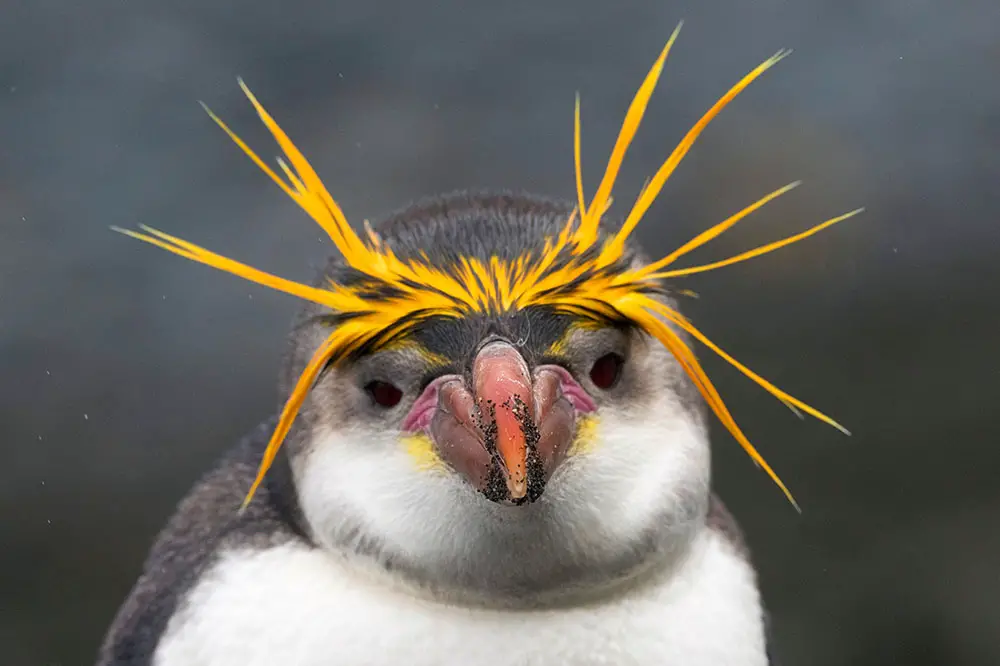
Northern & Southern rockhopper penguins | Eudyptes chrysocome & moseleyi
The rockhopper is another bird with a species status that has changed over the years but is now recognised as two distinct species the northern and southern rockhopper, with the latter further divided into two subspecies, the eastern and western rockhopper. The two species can be distinguished by their size and the length of their crest with the Northern rockhopper being slightly larger and sporting longer crest feathers.
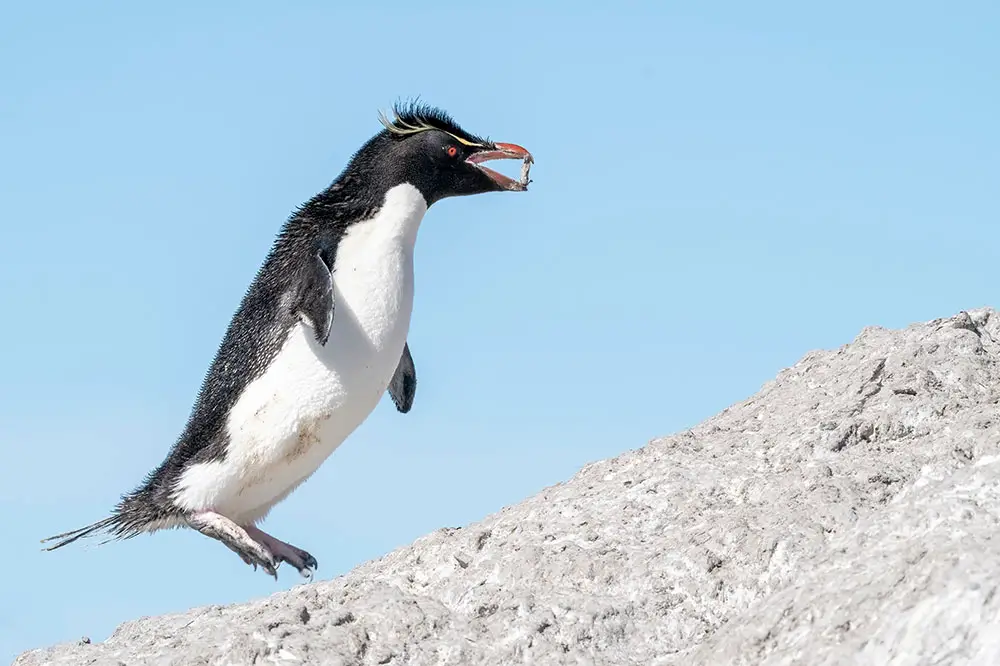
As the name suggests, these penguins are known for their agility in relation to navigating the rocky shorelines they inhabit, which applies both when travelling downhill and perhaps more impressively when travelling uphill as well. Like many species, chicks, which display a soft brown plumage, are vulnerable to other species of birds such as the giant petrel who prey upon chicks separated from the safety of the colony. In the waters just south of New Zealand, the aquatic range of the eastern rockhopper overlaps with that of another crested species and the only penguin to breed on Snares island.

Snares penguin | Eudyptes robustus
Snares penguin is named after this beautiful island, on which it breeds in colonies of up to 1,500 pairs. Before breeding commences in August, this species spends around four months at sea hunting for fish, which they do at speeds of up to 24 kph (15 mph). Snares penguin was considered a subspecies of the Fiordland penguin, but is now recognized as a distinct species and is identified by the presence of an area of bare skin that surrounds the base of the beak.

Fiordland penguin | Eudyptes pachyrhynchus
The Fiordland penguin lacks this patch of bare skin but can equal if not surpass the Snares penguin in the beauty of its breeding grounds for it is named after New Zealand’s spectacular Fiordland region. This species is also a little taller, standing around 22 in (55 cm) and can be distinguished from our final crested species by the presence of white feathers on its cheeks.

Erect-crested penguin | Eudyptes sclateri
The erect-crested penguin lacks this cheek colouration and also lacks the area of flesh at the base of its beak, distinguishing it from the Snares penguin. However, what this species lacks in facial colouration, it makes up for in height, standing ever so slightly taller than its colourful counterparts at 26 in (67 cm). Breeding season is a little later than the Snares penguin, commencing in September and once born its chicks sport a fluffy light brown plumage which moults into their waterproof adult feathers and spectacular hair piece. This species now breeds only on New Zealand’s Antipodes and Bounty islands but used to breed on mainland New Zealand along with its miniature cousin.
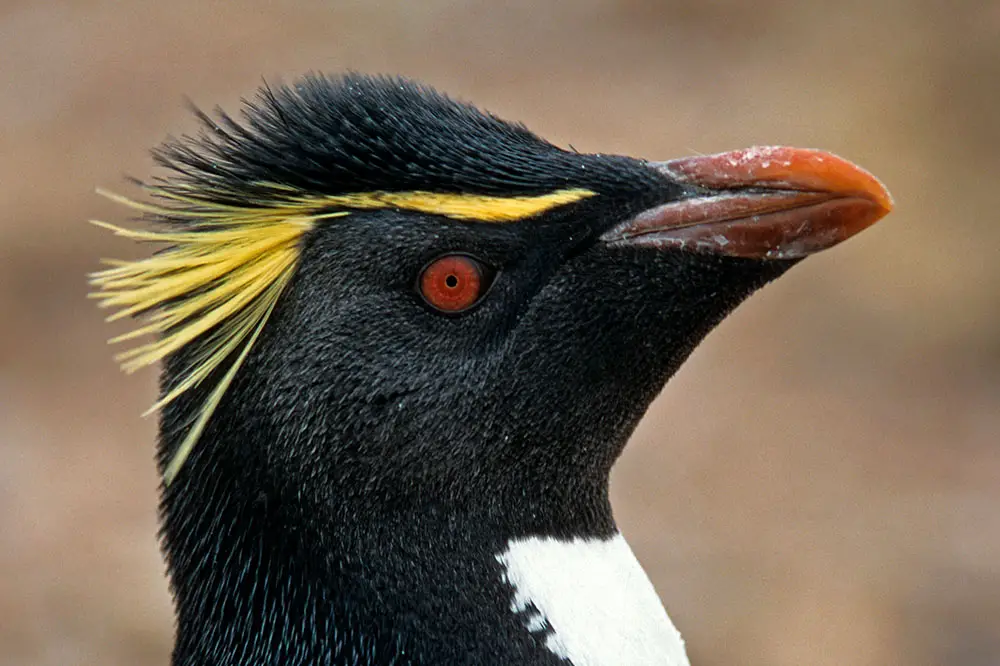
Little Penguins | Eudyptula
Little penguin & Australian little penguin | Eudyptula minor & novaehollandiae
The adorable little penguin is aptly named and is by far the smallest species, weighing under half the weight of the Galapagos penguin at no more than 2.6 lb (1.2 kg) and on average stands just 1 ft (30 cm) tall. Also known as the blue penguin or fairy penguin, in addition to its small stature, it is also characterised by a pale blue plumage on the dorsal side. It is another species that nests in burrows, dug either under vegetation or in the sand and breed once per year from June to December.
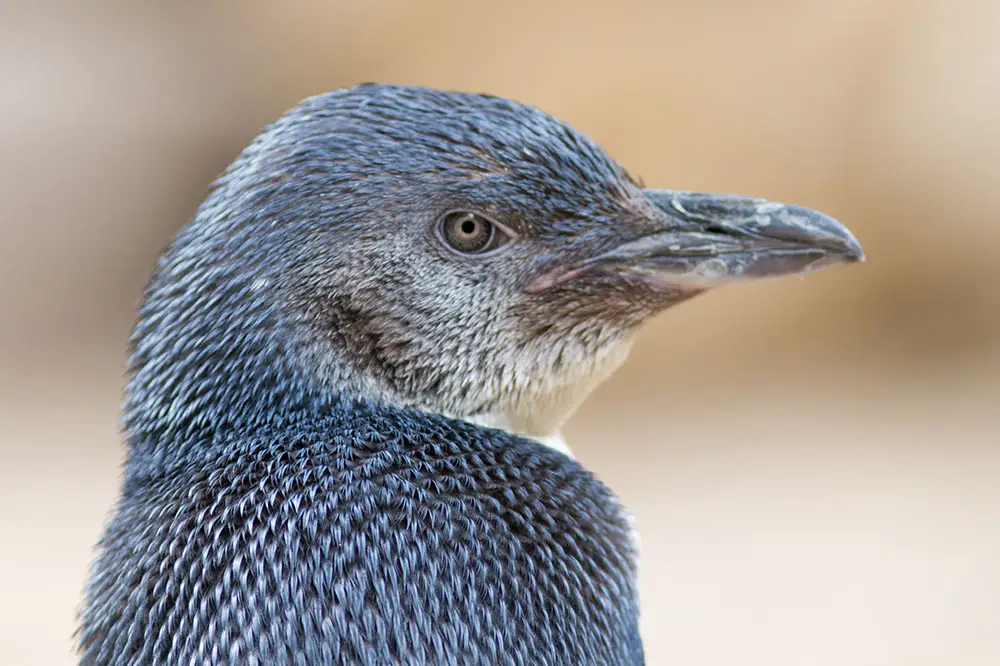
This bird is currently listed as a single species by both Birdlife International and the IUCN. However, two recent studies in 2017 & 2019 have suggested that one of the subspecies, named the Australian little penguin, is both morphologically and genetically distinct enough to be recognised as a separate species. The original species is found only in New Zealand whereas the proposed Australian little penguin is located both in Australia and the south coast of New Zealand where its range overlaps slightly with our final species found in its own monotypic genus.

Large Diver Penguins (Megadyptes)
Yellow-eyed penguin | Megadyptes antipodes
The yellow-eyed penguin is characterised, of course, by its yellow eyes but also by a set of yellow feathers on the head that are most prominent in a band that stretches from eye to eye around the back of the head. This species also exhibits bright pink feet and is not only unique in appearance but also in its mating behaviour. In addition to an abnormally long breeding season, running from August to March, this bird is not particularly social and will build its nest out of sight of other breeding pairs. The nest is usually concealed under dense vegetation and is most often categorised as a scrape, lined with twigs and other vegetation. The scrape nest is used by many birds and is one of 13 types of birds nest, all of which you can learn about in this video which features over 30 examples from different species. Thank you so much for watching.
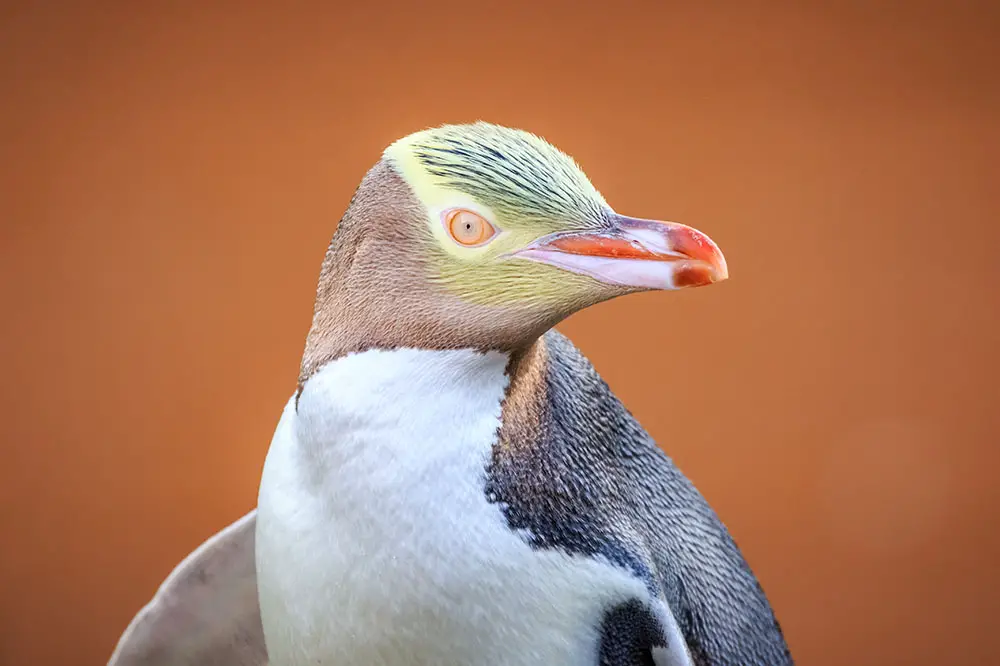
Sources
British Antarctic Survey, Australian Antarctic Program, Smithsonian, Birdlife International, Encyclopedia Britannica, National Geographic, Animal Diversity, Wikipedia, King penguin, Emperor penguin diving, Emperor breeding sites, Michael Phelps swimming speed, Gentoo penguin, Chinstrap penguin, Difference between leucism & albinism penguins, leucism vs albinism, African penguin, Penguin behaviour, Galápagos penguin, Humboldt penguin, Penguin mouth structure, Magellanic penguin, Magellanic vs African penguins, Macaroni penguin, Macaroni fashion style, Royal penguin, Northern/Southern rockhopper penguin, Macquarie Island birds, Snares penguin, Snares crested penguin, Little penguin, Australian little penguin & Yellow-eyed penguin.

